Abstract
From January of 1988 to May of 1993, simultaneous single-stage coronary revascularization and carotid endarterectomy was performed in 33 patients (mean age, 69 years). Thirty-one patients (94%) were in New York Heart Association class III or IV, 15 (46%) had unstable angina, and 7 (21%) were operated on because of evolving myocardial infarction. One or more previous myocardial infarctions were present in 18 patients (54%). Nineteen patients (58%) presented with neurologic symptoms, and 22 (67%) had severe bilateral carotid stenosis. Thirty (91%) had triple-vessel or left main coronary artery disease. Sequential reconstruction of the carotid artery followed by coronary artery bypass grafting was performed in all patients. In 4 cases, additional cardiac procedures were performed. Operative mortality (6%) was cardiac related. Perioperative morbidity included myocardial infarction in 1 patient (3%) and neurologic deficit in 6 (18%), with permanent functional impairment in 2 patients (6%). The stroke rate was higher in the bilateral than in the unilateral carotid stenosis group (22.7% vs 9.1%, p = 0.047). Previously completed stroke influenced the operative outcome (55.6% vs 4.2%, p = 0.003). Low ejection fraction (33.5% +/- 7.5% vs 52.8% +/- 3.5%, p = 0.03) and left main coronary artery disease (36% vs 5%, p = 0.03) also predicted postoperative neurologic complications. During a mean follow-up of 24.6 +/- 3.5 months, 3 patients died. The 5-year life-table survival rate was 85%. Eighty-nine percent of long-term survivors were free of cardiovascular disease symptoms. Our results show that the out come of simultaneous carotid endarterectomy/coronary artery bypass grafting in this high-risk population depends upon the preoperative absence or presence of completed stroke or bilateral carotid stenosis, upon the preoperative ejection fraction, and upon the extent of the left main coronary artery disease.
Full text
PDF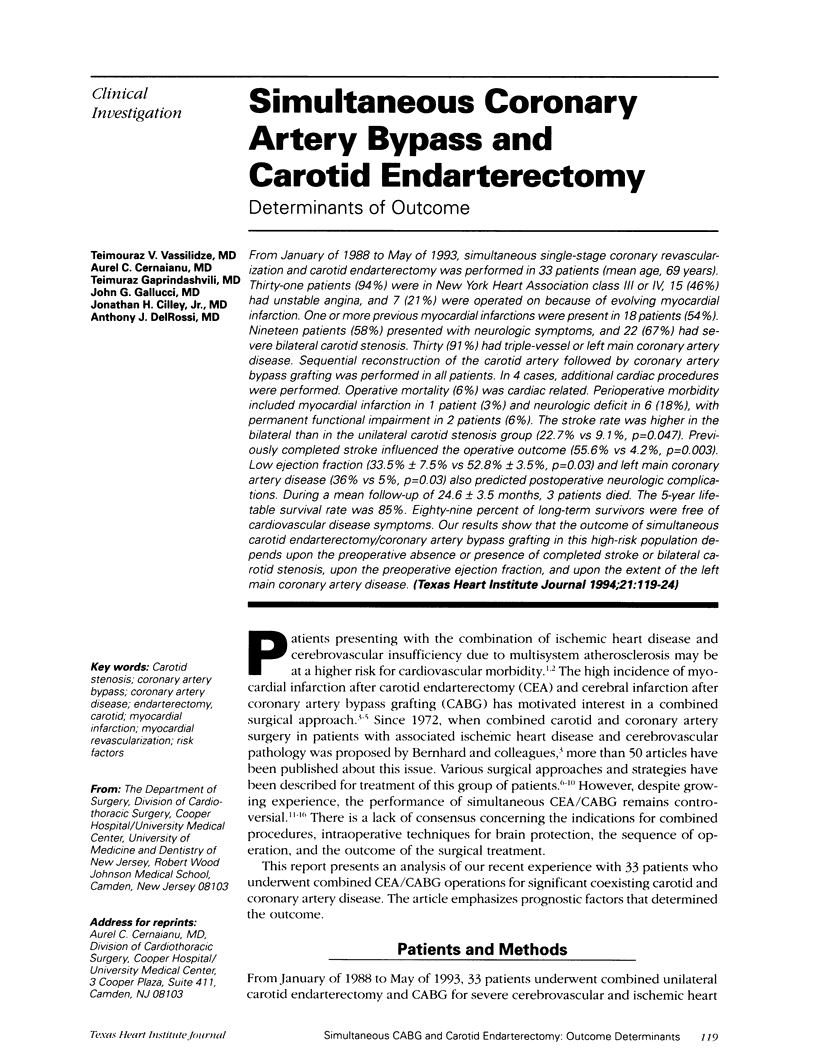
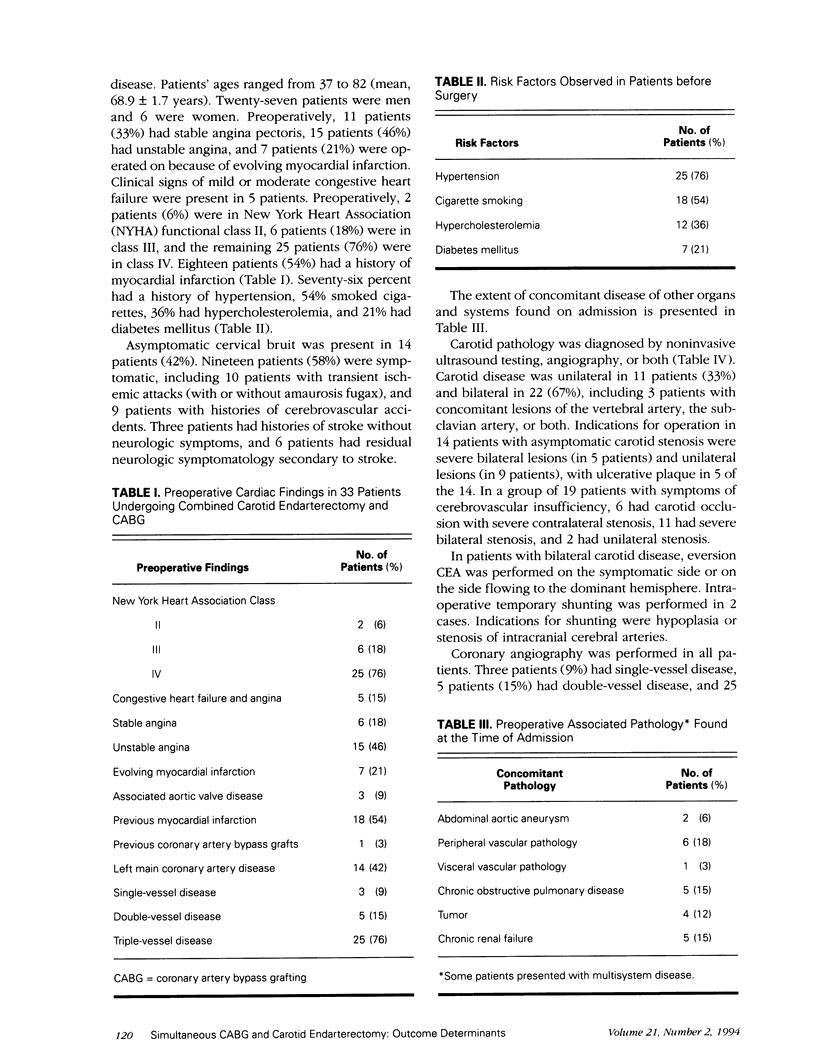
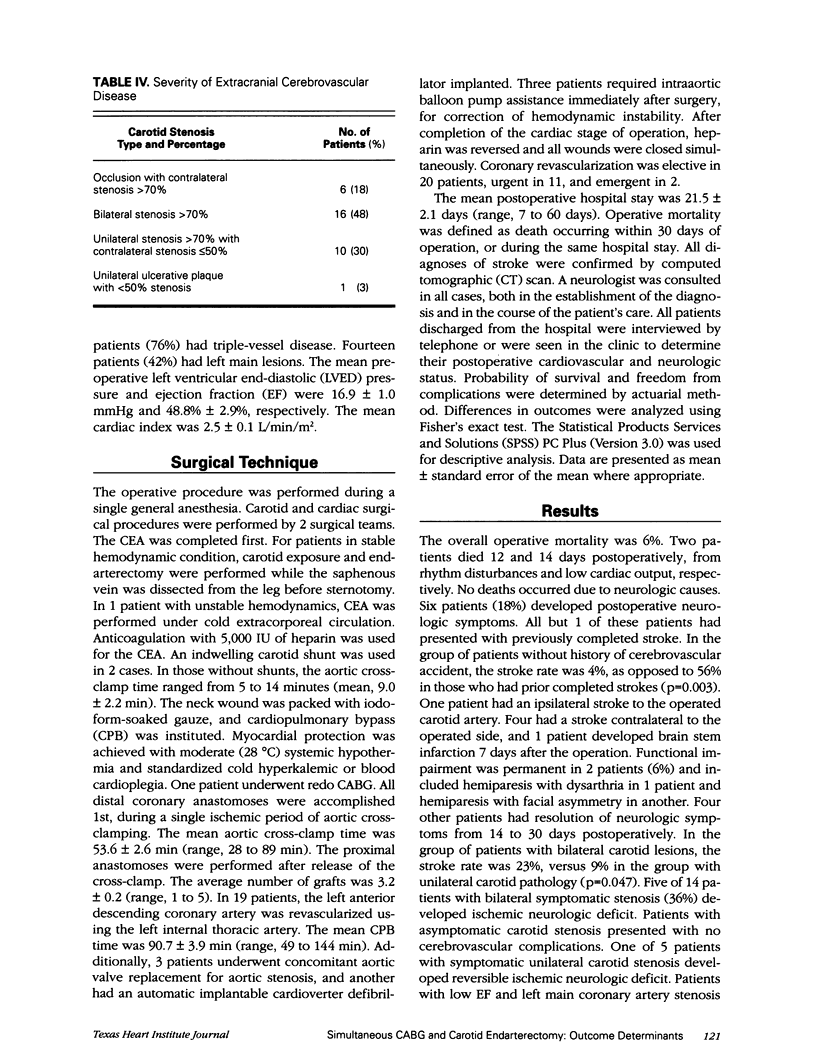
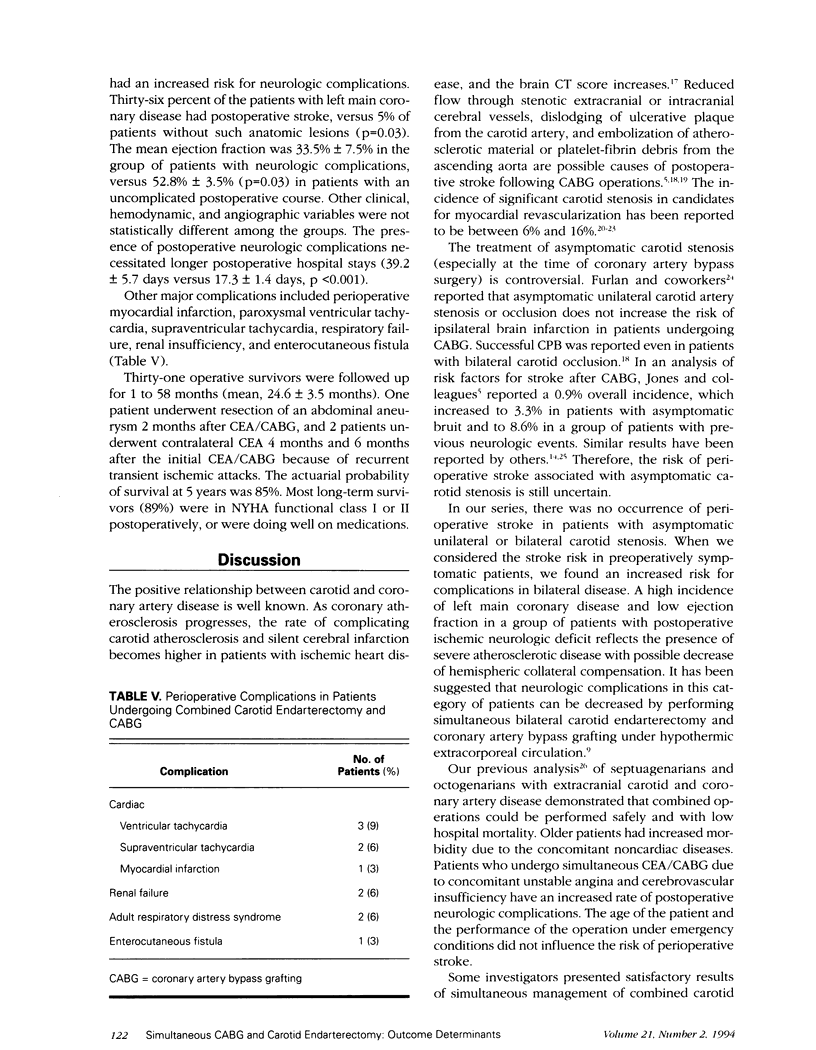
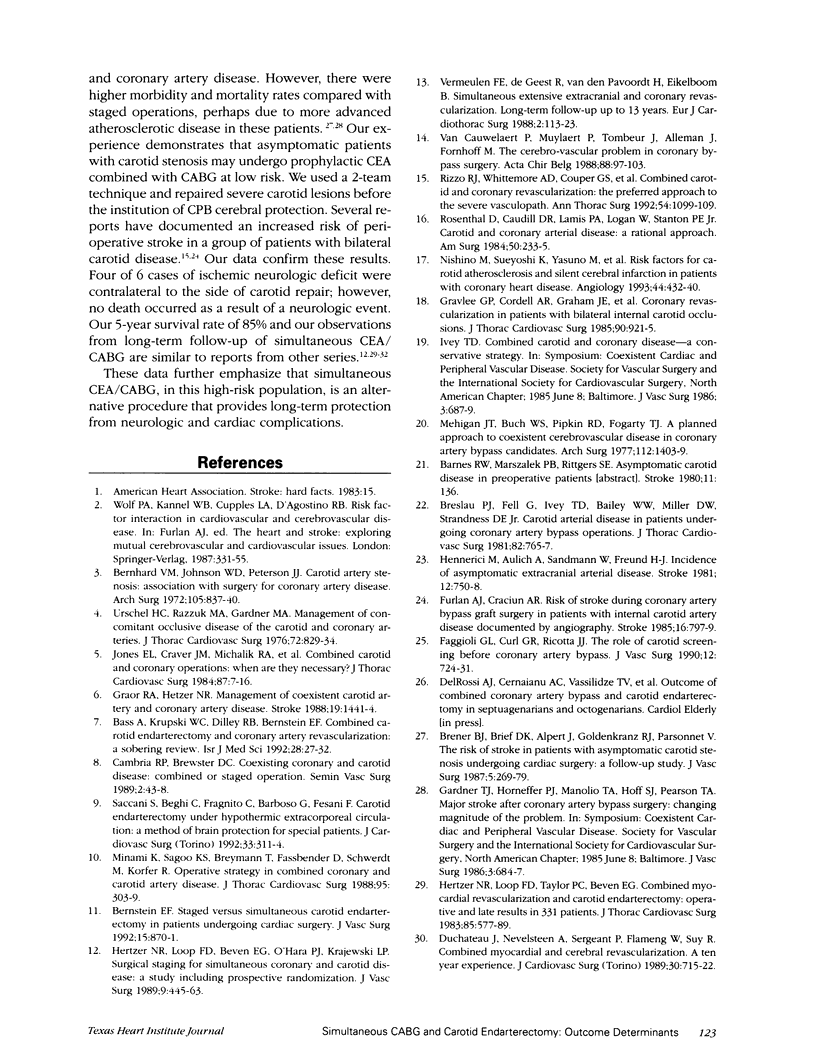
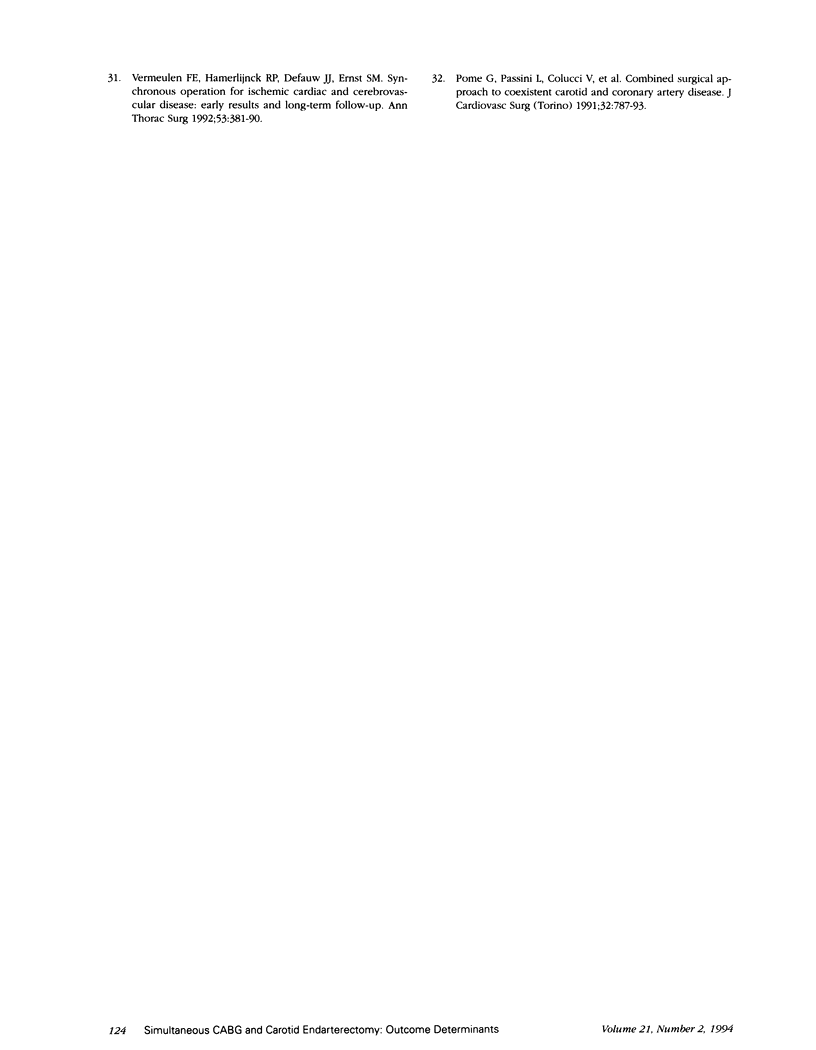
Selected References
These references are in PubMed. This may not be the complete list of references from this article.
- Bass A., Krupski W. C., Dilley R. B., Bernstein E. F. Combined carotid endarterectomy and coronary artery revascularization: a sobering review. Isr J Med Sci. 1992 Jan;28(1):27–32. [PubMed] [Google Scholar]
- Bernhard V. M., Johnson W. D., Peterson J. J. Carotid artery stenosis. Association with surgery for coronary artery disease. Arch Surg. 1972 Dec;105(6):837–840. doi: 10.1001/archsurg.1972.04180120018005. [DOI] [PubMed] [Google Scholar]
- Bernstein E. F. Staged versus simultaneous carotid endarterectomy in patients undergoing cardiac surgery. J Vasc Surg. 1992 May;15(5):870–871. doi: 10.1016/0741-5214(92)90725-n. [DOI] [PubMed] [Google Scholar]
- Brener B. J., Brief D. K., Alpert J., Goldenkranz R. J., Parsonnet V. The risk of stroke in patients with asymptomatic carotid stenosis undergoing cardiac surgery: a follow-up study. J Vasc Surg. 1987 Feb;5(2):269–279. [PubMed] [Google Scholar]
- Breslau P. J., Fell G., Ivey T. D., Bailey W. W., Miller D. W., Strandness D. E., Jr Carotid arterial disease in patients undergoing coronary artery bypass operations. J Thorac Cardiovasc Surg. 1981 Nov;82(5):765–767. [PubMed] [Google Scholar]
- Duchateau J., Nevelsteen A., Sergeant P., Flameng W., Suy R. Combined myocardial and cerebral revascularization. A ten year experience. J Cardiovasc Surg (Torino) 1989 Sep-Oct;30(5):715–722. [PubMed] [Google Scholar]
- Faggioli G. L., Curl G. R., Ricotta J. J. The role of carotid screening before coronary artery bypass. J Vasc Surg. 1990 Dec;12(6):724–731. doi: 10.1067/mva.1990.24458. [DOI] [PubMed] [Google Scholar]
- Furlan A. J., Craciun A. R. Risk of stroke during coronary artery bypass graft surgery in patients with internal carotid artery disease documented by angiography. Stroke. 1985 Sep-Oct;16(5):797–799. doi: 10.1161/01.str.16.5.797. [DOI] [PubMed] [Google Scholar]
- Graor R. A., Hetzer N. R. Management of coexistent carotid artery and coronary artery disease. Stroke. 1988 Nov;19(11):1441–1444. doi: 10.1161/01.str.19.11.1441. [DOI] [PubMed] [Google Scholar]
- Gravlee G. P., Cordell A. R., Graham J. E., Hudspeth A. S., Roy R. C., Royster R. L., McWhorter J. M. Coronary revascularization in patients with bilateral internal carotid occlusions. J Thorac Cardiovasc Surg. 1985 Dec;90(6):921–925. [PubMed] [Google Scholar]
- Hennerici M., Aulich A., Sandmann W., Freund H. J. Incidence of asymptomatic extracranial arterial disease. Stroke. 1981 Nov-Dec;12(6):750–758. doi: 10.1161/01.str.12.6.750. [DOI] [PubMed] [Google Scholar]
- Hertzer N. R., Loop F. D., Taylor P. C., Beven E. G. Combined myocardial revascularization and carotid endarterectomy. Operative and late results in 331 patients. J Thorac Cardiovasc Surg. 1983 Apr;85(4):577–589. [PubMed] [Google Scholar]
- Jones E. L., Craver J. M., Michalik R. A., Murphy D. A., Guyton R. A., Bone D. K., Hatcher C. R., Reichwald N. A. Combined carotid and coronary operations: when are they necessary? J Thorac Cardiovasc Surg. 1984 Jan;87(1):7–16. [PubMed] [Google Scholar]
- Mehigan J. T., Buch W. S., Pipkin R. D., Fogarty T. J. A planned approach to coexistent cerebrovascular disease in coronary artery bypass candidates. Arch Surg. 1977 Nov;112(11):1403–1409. doi: 10.1001/archsurg.1977.01370110137016. [DOI] [PubMed] [Google Scholar]
- Minami K., Sagoo K. S., Breymann T., Fassbender D., Schwerdt M., Körfer R. Operative strategy in combined coronary and carotid artery disease. J Thorac Cardiovasc Surg. 1988 Feb;95(2):303–309. [PubMed] [Google Scholar]
- Nishino M., Sueyoshi K., Yasuno M., Yamada Y., Abe H., Hori M., Kamada T. Risk factors for carotid atherosclerosis and silent cerebral infarction in patients with coronary heart disease. Angiology. 1993 Jun;44(6):432–440. doi: 10.1177/000331979304400602. [DOI] [PubMed] [Google Scholar]
- Pomè G., Passini L., Colucci V., Taglieri C., Arena O., Collice M., Pellegrini A. Combined surgical approach to coexistent carotid and coronary artery disease. J Cardiovasc Surg (Torino) 1991 Nov-Dec;32(6):787–793. [PubMed] [Google Scholar]
- Rizzo R. J., Whittemore A. D., Couper G. S., Donaldson M. C., Aranki S. F., Collins J. J., Jr, Mannick J. A., Cohn L. H. Combined carotid and coronary revascularization: the preferred approach to the severe vasculopath. Ann Thorac Surg. 1992 Dec;54(6):1099–1109. doi: 10.1016/0003-4975(92)90076-g. [DOI] [PubMed] [Google Scholar]
- Rosenthal D., Caudill D. R., Lamis P. A., Logan W., Stanton P. E., Jr Carotid and coronary arterial disease. A rational approach. Am Surg. 1984 May;50(5):233–235. [PubMed] [Google Scholar]
- Saccani S., Beghi C., Fragnito C., Barboso G., Fesani F. Carotid endarterectomy under hypothermic extracorporeal circulation: a method of brain protection for special patients. J Cardiovasc Surg (Torino) 1992 May-Jun;33(3):311–314. [PubMed] [Google Scholar]
- Urschel H. C., Razzuk M. A., Gardner M. A. Management of concomitant occlusive disease of the carotid and coronary arteries. J Thorac Cardiovasc Surg. 1976 Dec;72(6):829–834. [PubMed] [Google Scholar]
- Van Cauwelaert P., Muylaert P., Tombeur J., Alleman J., Fornhoff M. The cerebro-vascular problem in coronary by-pass surgery. Acta Chir Belg. 1988 Mar-Apr;88(2):97–103. [PubMed] [Google Scholar]
- Vermeulen F. E., Hamerlijnck R. P., Defauw J. J., Ernst S. M. Synchronous operation for ischemic cardiac and cerebrovascular disease: early results and long-term follow-up. Ann Thorac Surg. 1992 Mar;53(3):381–390. doi: 10.1016/0003-4975(92)90255-3. [DOI] [PubMed] [Google Scholar]
- Vermeulen F. E., de Geest R., van den Pavoordt H., Eikelboom B. Simultaneous extensive extracranial and coronary revascularization. Long-term follow-up up to 13 years. Eur J Cardiothorac Surg. 1988;2(2):113–123. doi: 10.1016/s1010-7940(88)80008-3. [DOI] [PubMed] [Google Scholar]


